
The NZ flag on the back of our Milford Sound cruise boat.
New Zealand is, quite simply, magical. For any person who appreciates nature or the bounties of this planet, NZ is where it’s at! We’ve never been to any place that has been so consistently beautiful. There are only 4 million people on this island (3 million on the north island and 1 million on the south), so you will often have entire beaches, holiday parks, or hiking trails all to yourself.
Traveling in a camper van is the way we did it, and definitely the way we would do it again…though it may be just as nice (and cheaper) traveling in a rental car with a tent (you’ll have to cross your fingers for good weather). Driving long distances in NZ is not hard, because the scenery is so beautiful and the sights so different and engaging around each bend that you stay interested throughout the drive.
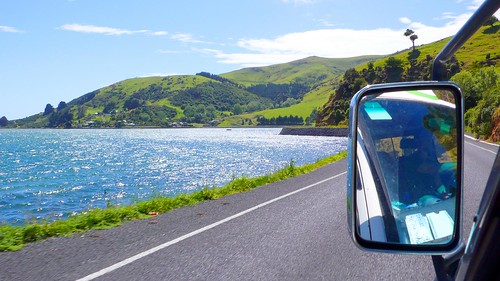
A typically beautiful NZ drive: on the Otago Peninsula.
Traveling here is incredibly easy. The staff at local i-Sites (NZ tourist information centers) are super nice and helpful. Road signage is quite good and we recommend you pick up a New Zealand Traveler’s Road Atlas by kiwimaps (costs around NZ$25) at a local supermarket or i-Site. Even if your car comes with a touring map or you have a guide book, it’s worth it. They are super easy to use and labeled with icons that tell you what the local activities are (ex. fishing, surfing, etc.) and what towns have holiday parks where you can camp.
We don’t have the same bias towards the south island that a lot of our friends have…we truly love them both equally. If we had to do it over again, we would stay here an extra week or two so we could spend a bit more time in some places.
Days spent here: 28
Number of Kilometers Traveled: 5000+
Average Daily Expenditures: US$140 (sorry, did some bad accounting…the total was actually:) US$120; the van was approx. USD$43 per day, so additional expenses were on holiday park fees, gas, internet access, food, ferries, clothing, etc. (Note: towards the beginning of the trip, we were not as careful and were averaging $170/day. We made a few changes and significantly reduced our daily average, see below for details.)
Prices: A bit cheaper overall than US prices, though not as cheap as you might hope.
Weather: It can get quite cold in NZ, and very windy (Hope was quite happy she brought her lightweight down jacket). Weather tends to be pretty extreme: either full sun and blue skies or cloud cover with rain. It’s best to prepare for all conditions.
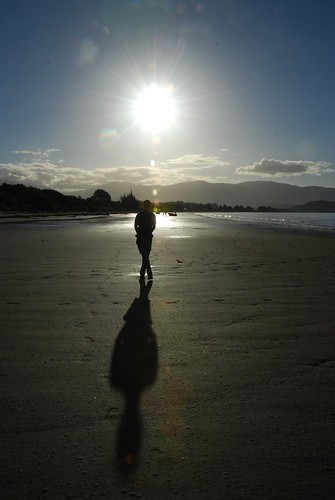
Beautiful, sunny Pohara Beach.
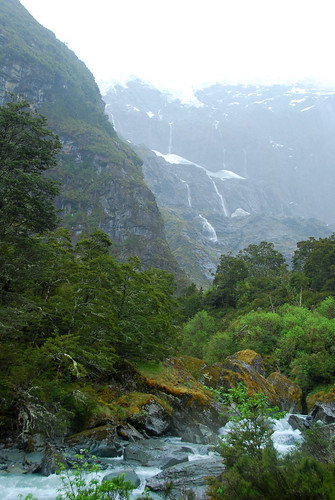
Cold and rainy near the Rob Roy glacier.
North Island Highlights: Driving around Mt. Tanaki/Egmont (SH45—the “surf highway”), east coast of Coromandel Peninsula, Wellington
South Island Highlights: Nelson (esp. Whariki Beach), Wanaka, Milford Sound, Otago Peninsula
Places we wish we could have visited: Stewart Island, Mount Cook, Bay of Islands
What we would do the same: Travel in a camper van.
What we will do differently next time: Stay a week or two or ten longer; skip the west coast of the south island (which is a sand fly convention) and explore the middle of the island more; charter a boat and explore Fiordland; see the areas north of Auckland; multi-day hut-to-hut hikes near Wanaka and Milford; watch the extended version of the Lord of the Rings trilogy while traveling around NZ.
How we kept the costs down:
- We cooked A LOT…we only ate out 11 times in the 28 days (x 3 meals) we were here. Partly this is because the food here is so similar to food in Northern CA, so we didn’t feel like we were missing out by cooking so much.
- Freedom camped every other night instead of staying in holiday parks.
- Avoided touristy experiences: For example, we decided not to pay the NZ$31 to go into Orakei Korako.
- Ate less meat: even though it is cheaper here, it is still a large portion of the grocery costs, so we started using it more as a flavoring and less as a main part of the dish.
- Took advantage of free wi-fi in the libraries of major cities.
- Used our fuel vouchers (see below).
Internet: Surprisingly, not a great internet situation here. Virtually every holiday park has wireless access, so it is widely available, but it can be expensive—up to NZ$10 per hour. Maybe this isn’t outrageous, but we were expecting it to be cheaper. Also, internet access can often be limited not just by time, but by the amount of data transfered (ex. 50 MB max). A few times, we purchased 2 hour access, only to reach our data limit within 30 minutes. According to a tech guy we corresponded with, this is because NZ is one of the only first-world countries that still has data restrictions. (Note: After traveling Australia, where internet access at holiday parks is not a given, we are amending our opinion of NZ’s internet situation in a positive direction).
Favorite Grocery Store: New World—They have the best and highest quality selection, by far.
Least Favorite Grocery Store: Fresh Choice—we found a worm wriggling out of a slice of ham we bought from the deli counter there. ‘Nuff said.
Food: Super fresh meat and veggies. Obviously, lamb is extremely top-quality here, but so is beef and pork. Jeremy has some beef (ha ha) with the way meat is butchered here, however. Often a pork chop or cut of steak will include a lot of fat and the “rind” (the skin). A little creepy for us Americans.
The grocery store sells about 17 million different varieties of bacon. Animal products like cheese and eggs are also amazing. Most grocery stores do not sell beyond lamb, beef, chicken, and pork (i.e., no turkey).
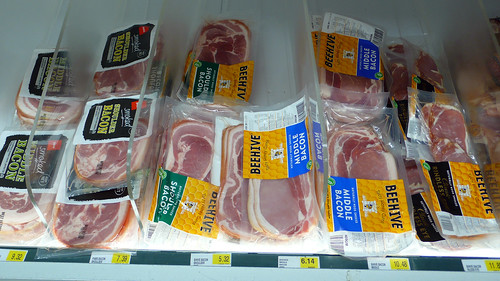
The bacon selection in a tiny little grocery store…this was probably equal to their entire produce section. ![]()
Veggies here are also super fresh and for some reason, asparagus was super cheap while we were here. However, garlic was often really bad (wilting and sprouting). The best part of grocery shopping in NZ is that there are often little farms along the road and you can just pull over and buy ultra fresh veggies, fruit, or eggs from the residents.
Holiday Parks: Holiday parks are large campgrounds that offer powered sites (for camper vans like ours that can plug in) and non-powered sites (for tents), hostel-like accommodations, or “self-contained” units (rooms with kitchen and bath included). Obviously, we only used the power sites in holiday parks so we can’t vouch for the self-contained or bunk units. All power sites come with power hookup and a water spout, as well as access to communal kitchens (the nicer holiday parks have soap, sponges, pots, pans, etc…others don’t, but our van came with all of that), bathroom and showers (sometimes you have to pay for the showers, sometimes you don’t), and access to other amenities like a TV room (free), playgrounds and trampolines for the kids, laundry (prices differ), or, in the case of the last holiday park we stayed in, a hot mineral pool. To stay at a power site in a holiday park generally costs between NZ$24 and $36 per night. The fancier parks near the big cities are more expensive and have nicer amenities, but we tend to like the ones out in the middle of nowhere since they are quieter and usually family-run. It seems like all holiday parks in NZ have wireless internet access (cheaper in the big cities).
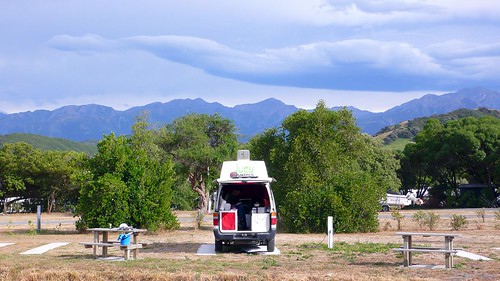
Cool clouds behind the holiday park in Peketa.
Most holiday parks are located on incredibly beautiful plots of land with sensational views. Some holiday parks seem to allow long-term residents, so it is a cheap way for Kiwis to have a vacation home in a prime location.
Gas/Petrol: While we were in NZ, the price fluctuated between NZ$1.16 and NZ$1.23 per liter for diesel (approx. US$2.71 per gallon). It seems that gas prices are kept at a pretty consistent rate from station to station (unlike in the US where the prices can vary from block to block). The one exception is in hard-to-get-to places, like a town at the end of a peninsula or something similar (where gas can be more expensive).
Also, important note: if you spend more than a certain amount (I think it is NZ$25) at some of the bigger grocery stores, you will get a coupon for 4 cents off every liter of fuel you purchase. For example, New World gives you a discount at BP; Woolworth’s gives you a discount at Shell, etc. Be sure to keep these coupons! The savings really add up.
Surf: The surf was a little disappointing for us (or for Jeremy anyway). There are so many deserted beaches, rocky points, and river mouths which must product amazing waves with the right swell and tide. But we were there in the spring which, it seems, has less consistent swell than other times of the year. The swells that did come through tended to only produce waves for a few hours or half a day. On the flip side, no waves meant that we were free to explore everything else that New Zealand had to offer, which is plenty.
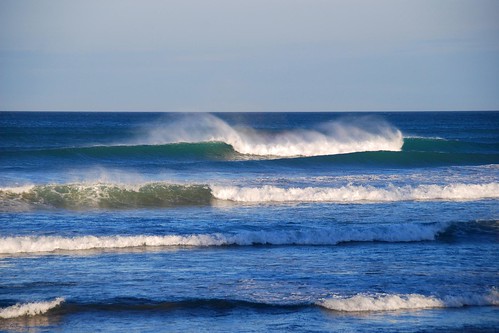
Nice-looking “rooster tails” at Waihi Beach.
We did meet up with a good swell our last few days in New Zealand in the Coromandel region of the North Island. There were fun waves at an empty beach break (Jeremy was the only one in the water) at Waihi. And there were exceptional waves (overhead, endless lefts; 10 waves per set) at a very crowded point break at Whangamata. Other areas that looked promising for a future trip: Raglan (of course), “The Surf Highway” to the south of New Plymouth, the Otago Peninsula (near Dunedin) and the Banks Peninsula (near Christchurch).
The water is cold on the South Island; Jeremy brought his 4/3 wetsuit, booties and hood and would have needed them all if he got in the water. It is quite a bit warmer around the North Island; Jeremy surfed a few times in shorts and a neoprene rash guard (not quite warm enough) and a few times in his wetsuit (way too warm). A shorty would have been better.
Hiking: The hiking in New Zealand is superb. There are endless beaches, rolling pasture land, sub-tropical rain forests, mountains and glaciers to explore. The i-Sites typically have good regional maps and recommendations for hikes of varying length and difficulty. As we have mentioned a few times already, we were surprised again and again at how accurate the estimated hiking times are. Each time we (or Jeremy) would say “there is no way that hike is going to take us 5-6 hours!” But sure enough, even at a strenuous pace and few rest stops, that hike would take us 5.5 hours.
In addition to day hikes, New Zealand has an extensive network on wilderness huts that you can reserve for multi-day trips. The ones we saw were basic but they are plenty to protect you from a storm or cold weather and let you leave the tent behind. We will definitely need to take advantage of these next time.
In Short: We LOVE New Zealand! We have a hard time even thinking of one spot that was not incredibly beautiful. NZ is definitely a country we will return to for an extended trip or maybe to live? ![]()
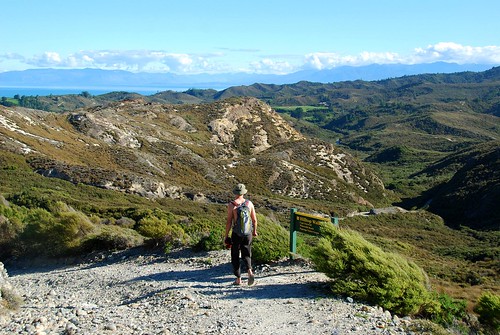
Ooh, Ooh, Ooh! LOVE the summary style.